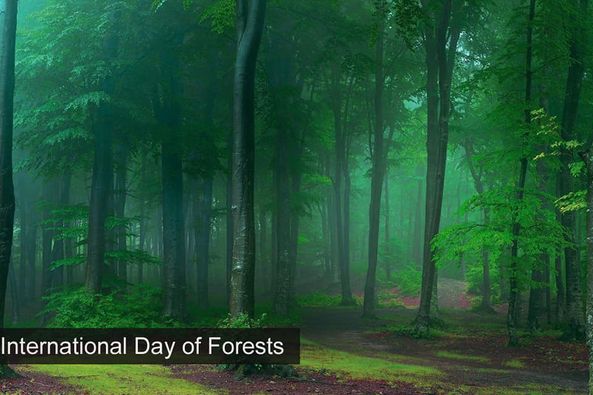Franklin D. Roosevelt, a former United States President asserts that “a nation that destroys its soils destroys itself; forests are the lungs of our land; purifying the air and giving fresh strength to our people,” this illustrates the importance of forests not only to humanity, but also animals and the environment.
The life cycle of plants and animals directly or indirectly depend on the forest and its by-products for survival. As observed by the Food and Agriculture Organization (FAO), forests are unique to human existence; the most natural efficient ecosystems with high rate of photosynthesis that affects both plant and animal systems. Affirming that due to its economic importance, forest provides food, water, medicine, furniture, cosmetics, writing materials, shelter, as well as habitat for biodiversity for about 80 percent of the world’s diverse animal species and terrestrial settlements.
In the same vein, forests are the largest house of carbon. They provide ecosystem services that are critical to human welfare. These include absorbing harmful greenhouse gases that produce climate change, protecting watersheds and reduces the amount of erosion and chemicals washed into the waterways, farms, and serves as buffer to natural disasters like flood and rainfall. Consequently, in service to complex organic relationships, forests occupy about 30 percent of the earth surface containing approximately 3 trillion trees that exist in dry, wet, freezing, cold and scorching hot climates and they are categorised based on their distance from the equator. They are equally classified according to latitudes; for instance, tropical forests are found between 23.50N and 23.5 0S. The temperature in these areas range between 680 and 77 0F through the year. Temperate forests are found in China, Japan, Western Europe and parts of Russia as well as United States and Canada. Boreal forests are located between 50 0S and 60 0N, found in Siberia, Canada, Northern Asia and Scandinavia etc.
However, deforestation which include, clearing, burning, and destruction of trees through deliberate, natural or accidental means has depleted the usefulness of forests to humanity in recent times. This occurs in areas densely populated by tress and other plant life but majority of it currently happens in the Amazon rain forests. The loss of trees and vegetation causes climate change, desertification, soil erosions resulting in shortage of food, increased flooding, greenhouse gases in the atmosphere and a host of other problems.
Deforestation also occurs due to faming activities, extensive cattle ranching, logging for materials and other development activities. It is against this background that there is need for the regulation and the planning of the management of forests in the society. This includes, the regulation and planning of cutting of trees, control over bush burning, forest fire and reforestation of trees for sustainable production of human needs and consumption for growth.
“The sustained yield concept” of forestation dictates that whenever trees are removed either by burning, cutting or selective cutting, the removed area should be reforested by natural or artificial methods to avert the harms of deforestation. This explains why countries across the world are particular about conservation of its forests and natural resources. Hence, several rules and regulations for the protection of forests. For example, Nigeria has over the years passed laws for the categorisation and delimitation of forests for conservation in the country. Some of these include: Afi River forests reserve in Cross River State, Akure Forest reserve in Ondo State, Edumanam forest reserve in Delta State, Idanre forest reserve in Edo State, Ngel Nyak forest reserve, Oba Hills forest reserves, Okumu forest reserve, Oluwa forest reserve, Ise forest reserve, Okeluse forest reserve, and others.
In Bayelsa State for instance, successive administrations have put in place measures aimed at protecting the rich natural resources of the forests scattered across the State. Some notable rich mangrove forests along the Coastal communities include; Ogbohu forest, Itelebou forest, Asam forest, Agbagene forest, Ogugu forest of Azikoro Village, etc all in Yenagoa Local Government Area. Also, the Agadagba forest of Sabagria in Kolokuma/Opokuma Local Government Area, Bunu forest of Futorugbene in Ekeremor Local Government Area, Otokiri of Peremabiri in Southern Ijaw Local Government and a host of others in the State. Thus, the employment of over two hundred forest guards, the passage of the Anti-open grazing law 2021 and other measures, are forest management policies and programmes worthy of note.
Despite the efforts of governments and private organisations in the management of forests in the country, its depletion due to human and natural disasters pose serious problems. Hence, the introduction of new techniques for the conservation of existing forests, introduction of research programs for the efficient use and conservation of forests, training and retraining of persons in forest conservation activities, as well as the use of forest lands as tourist centers will go a long way to help protect forests.
Also, the introduction of new polices, and proper implementation as regards the commercial use of forest products, control of mining activities, development of natural parks, logging activities and other forest developmental activities, like social forestry, agro forestry, effective implementations of anti-open gracing laws and the preparation of master plans both long and short term for forestation and reforestation activities in the country aimed at boosting the rich natural heritage of the environment, will be most effective. However, country that destroys its environment without putting in place measures to mitigate the adverse effects on its citizens destroys itself. Deforestation by all means should be reconsidered with alternative measures, to promote forest sustainable production and consumption.
Nicodemus S. Dauebi
Bayelsa State Min. of Information, Orientation and Strategy









